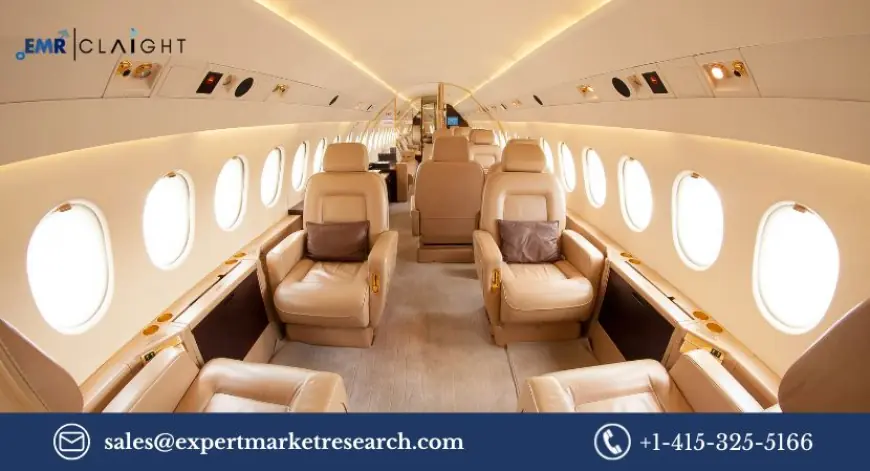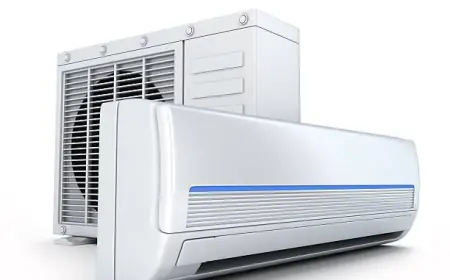Aircraft Cabin Interior Market: Trends, Growth, and Forecast (2025-2034)
The aircraft cabin interior refers to all the interior components of an airplane, such as seating arrangements, lighting systems, overhead bins, floor systems, galleys, lavatories, and aircraft windows.

The aircraft cabin interior market is evolving rapidly, driven by the growing need for enhanced passenger comfort, improved aesthetics, and advanced technologies that optimize cabin performance. In the forecast period of 2025 to 2034, the global aircraft cabin interior market is expected to grow at a compound annual growth rate (CAGR) of 3.20%. This market growth is largely attributed to the increasing demand for air travel, the need for more energy-efficient aircraft, and the rising expectations of passengers for better in-flight experiences. This article provides a detailed overview of the aircraft cabin interior market, covering aspects such as market size, share, dynamics, growth, opportunities, challenges, and competitor analysis.
Overview of the Aircraft Cabin Interior Market
The aircraft cabin interior refers to all the interior components of an airplane, such as seating arrangements, lighting systems, overhead bins, floor systems, galleys, lavatories, and aircraft windows. The demand for high-quality cabin interiors is increasing as airlines and aircraft manufacturers prioritize passenger comfort and safety while improving the overall in-flight experience.
The cabin interior industry has witnessed significant advancements over the past few years, with airlines seeking to enhance the aesthetics of their cabins and offer better services to passengers. New designs and technologies, such as personalized in-flight entertainment (IFE) systems, advanced lighting solutions, and ergonomic seating, are transforming the way passengers experience air travel. Moreover, the growing trend of low-cost carriers is also contributing to the expansion of the aircraft cabin interior market.
As air travel continues to grow globally, airlines are investing in modernizing their fleets to meet customer demands. In addition, the increase in the number of aircraft deliveries and the replacement of aging fleets are expected to drive the demand for upgraded cabin interiors.
Get a free sample request: https://www.expertmarketresearch.com/reports/aircraft-cabin-interior-market/requestsample
Size and Share of the Aircraft Cabin Interior Market
The global aircraft cabin interior market is expanding steadily. In 2024, the market was valued at approximately USD 25.76 billion, and it is expected to reach around USD 34.75 billion by 2034, growing at a CAGR of 3.20% between 2025 and 2034. The market size and share are influenced by several factors, including the number of aircraft being manufactured, the demand for retrofitting older planes, and the increasing focus on passenger comfort and cabin aesthetics.
Market Share by Type of Aircraft
The aircraft cabin interior market is segmented based on the type of aircraft, with commercial aircraft, regional aircraft, and business aircraft representing the main categories.
-
Commercial Aircraft: The commercial aircraft segment holds the largest share of the aircraft cabin interior market. This segment includes narrow-body, wide-body, and very large aircraft (VLA) used for passenger flights. The increasing number of passengers and the growth of air travel demand are major factors driving the need for improved cabin interiors in commercial aircraft.
-
Regional Aircraft: Regional aircraft, typically smaller than commercial aircraft, also require advanced cabin interiors, especially as demand for regional travel rises. These aircraft primarily cater to shorter routes and smaller airports, where efficient use of cabin space and comfort features are essential.
-
Business Aircraft: Business aircraft, including private jets, have been witnessing a rise in demand for luxurious and highly customizable cabin interiors. As business travel grows globally, the demand for high-end, comfortable, and technologically advanced interiors is expected to increase in this segment.
Market Share by Product
The market is also divided based on the different types of aircraft cabin interior components, such as seats, lighting, windows, storage, and galleys:
-
Seats: Seats are one of the most significant components of aircraft cabin interiors. With growing emphasis on passenger comfort, airlines and manufacturers are focused on offering ergonomic seating options with features such as adjustable legroom, lumbar support, and recline mechanisms.
-
Lighting: The lighting segment is growing due to the increasing demand for mood lighting systems that create a relaxing and comfortable atmosphere for passengers. Advanced lighting systems also help airlines save energy and reduce maintenance costs.
-
Windows: Aircraft windows are also a key component of the cabin interior, with advancements in technologies like electrochromic windows that can be adjusted to control the amount of light entering the cabin.
-
Galleys and Lavatories: Galleys and lavatories are integral parts of the cabin interior, with airlines seeking more efficient, space-saving designs that improve operational performance while maintaining passenger convenience.
Market Dynamics and Trends in the Aircraft Cabin Interior Market
The aircraft cabin interior market is influenced by various market dynamics and trends, including technological advancements, changing consumer preferences, and industry challenges. Below are the key dynamics and trends impacting the market:
Technological Advancements
One of the major drivers of the aircraft cabin interior market is the continuous innovation in cabin technologies. New technologies are improving both the functionality and aesthetics of cabin components. Some key innovations include:
-
Personalized In-Flight Entertainment Systems: With increasing demand for individualized experiences, airlines are investing in advanced in-flight entertainment systems, including seat-back screens, wireless streaming, and connectivity solutions that allow passengers to access content on their devices.
-
Smart Cabin Solutions: The rise of "smart" cabin solutions is reshaping the way airlines design and operate aircraft interiors. Smart cabins equipped with IoT (Internet of Things) technologies allow airlines to monitor and adjust cabin temperature, lighting, and air quality in real time, improving passenger comfort and reducing operational costs.
-
Eco-friendly Materials: Airlines are increasingly adopting sustainable materials for cabin interiors. Eco-friendly seat materials, lightweight composites, and non-toxic finishes are gaining popularity as airlines seek to reduce their environmental impact and meet sustainability goals.
Rising Demand for Passenger Comfort
As competition among airlines intensifies, there is a growing focus on improving the passenger experience. Modern passengers expect more than just basic comfort during their flights; they want high-quality cabin interiors that enhance their travel experience. Airlines are responding by investing in new designs, including spacious seating, more advanced lighting, and customizable entertainment options, all of which contribute to the market's growth.
Focus on Cabin Customization
Customization is a growing trend in the aircraft cabin interior market. Airlines are increasingly opting for tailored cabin designs that reflect their brand identity and cater to the specific preferences of their passengers. From seat configurations to lighting schemes, airlines are focused on creating a unique in-flight experience that aligns with their target market's needs.
Impact of COVID-19
The COVID-19 pandemic had a significant impact on the aviation industry, causing a temporary decline in air travel. However, as the world recovers and air travel resumes, airlines are investing in enhancing cabin interiors to ensure passenger safety and comfort. Enhanced air filtration systems, touchless interfaces, and antimicrobial materials are becoming more prevalent as part of the effort to make the cabins safer for passengers and crew.
Growth of the Aircraft Cabin Interior Market
The global aircraft cabin interior market is experiencing steady growth, fueled by several factors:
Increased Air Travel and Fleet Expansion
As air travel rebounds post-pandemic, the demand for new aircraft and retrofitting older fleets to enhance cabin interiors is on the rise. The growing number of passengers, particularly in emerging markets, is driving airlines to modernize their fleets with state-of-the-art cabins designed to offer enhanced comfort and performance.
Airline Investments in Premium Services
The increasing demand for premium services such as first-class, business-class, and premium economy seating is another significant growth driver. Airlines are focusing on providing exceptional passenger experiences in these classes, often featuring luxury seats, cutting-edge entertainment systems, and high-end amenities.
Advancements in Aircraft Design and Manufacturing
As aircraft manufacturers like Boeing and Airbus develop more fuel-efficient and advanced aircraft, they are also focusing on optimizing the cabin space. New aircraft designs, such as the Boeing 787 and Airbus A350, provide more flexibility in terms of cabin layouts and offer improved comfort for passengers.
Market Opportunities and Challenges
Opportunities
-
Emerging Markets: The demand for air travel is rapidly increasing in emerging economies such as China, India, and Southeast Asia. These markets present significant growth opportunities for the aircraft cabin interior market as airlines seek to improve their fleets to meet the needs of a growing middle class.
-
Eco-friendly and Sustainable Solutions: The rising demand for sustainable materials and eco-friendly cabin solutions is creating opportunities for manufacturers to develop innovative and environmentally responsible products. Airlines are increasingly prioritizing sustainability as part of their corporate social responsibility (CSR) goals.
-
Retrofit Market: Airlines are investing in retrofitting their existing fleets to meet passenger expectations. This market represents a significant opportunity for manufacturers of cabin interior components to supply upgrades for older aircraft.
Challenges
-
High Costs of Cabin Interiors: High-quality aircraft cabin interiors can be expensive to design and manufacture. Airlines face pressure to balance cost efficiency with providing a comfortable and innovative in-flight experience.
-
Regulatory Compliance: Aircraft cabin interiors must comply with strict regulatory standards set by aviation authorities, including safety, fire resistance, and weight restrictions. These regulations can pose challenges for manufacturers and increase development time and costs.
-
Supply Chain Disruptions: The global supply chain for aircraft manufacturing and cabin components is susceptible to disruptions, including delays in materials and components. This can impact the timely delivery of cabin interior products.
Competitor Analysis
The aircraft cabin interior market is highly competitive, with several key players dominating the industry. These companies have extensive experience in manufacturing and designing cabin interiors for commercial, regional, and business aircraft.
-
Diehl Stiftung & Co. KG: A leading supplier of cabin interior products, including seating, lighting, and cockpit components, Diehl focuses on innovative and sustainable solutions for the aviation industry.
-
Safran Group: Safran is a global leader in aerospace equipment and services, including aircraft cabin interiors. The company offers a wide range of products, including seating systems, lighting, and galleys.
-
JAMCO Corporation: JAMCO provides high-quality cabin interiors, including seating and partition systems, for both commercial and business aircraft. The company is known for its customizable cabin solutions and innovative designs.
-
Boeing EnCore Interiors, LLC: Boeing EnCore specializes in providing premium interior solutions for commercial aircraft. The company offers seating, overhead bins, and other components for both new aircraft and retrofitting older models.
-
Geven S.p.A.: Geven is an Italian company specializing in seating systems and cabin interiors for commercial aircraft. The company is known for offering high-quality, lightweight, and customizable seating solutions.
The competition in the aircraft cabin interior market is intensifying, with these key players continuously innovating to meet the evolving needs of the aviation industry. Their focus on passenger comfort, safety, sustainability, and advanced technologies is shaping the future of the market.
Toy Manufacturers:
https://www.expertmarketresearch.com/articles/top-toys-companies
What's Your Reaction?
 Like
0
Like
0
 Dislike
0
Dislike
0
 Love
0
Love
0
 Funny
0
Funny
0
 Angry
0
Angry
0
 Sad
0
Sad
0
 Wow
0
Wow
0

















































